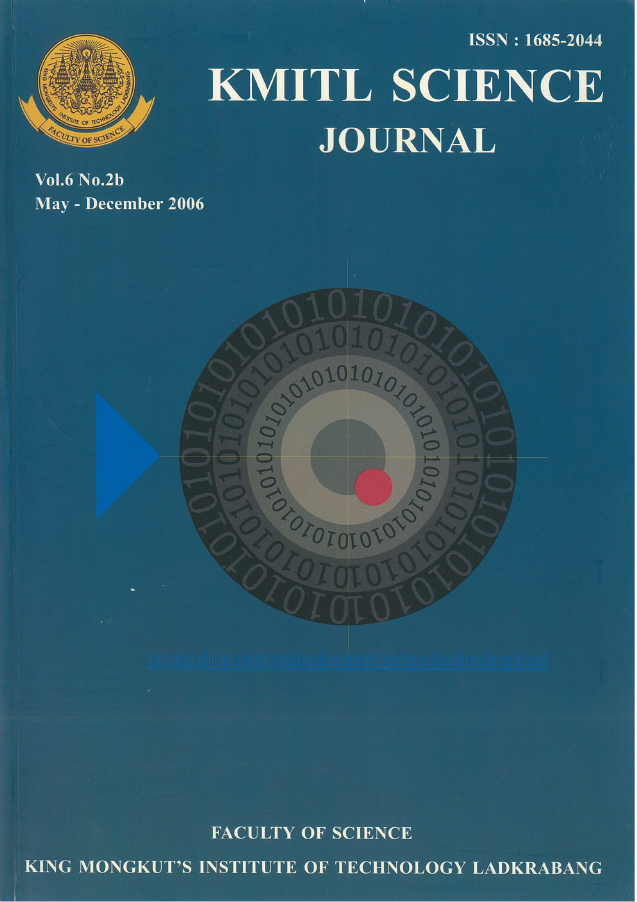Purification and Characterization of Glucoamylase from Aspergillus niger ATCC 10864.
Main Article Content
Abstract
The Aspergillus niger ATCC 10864 produced substantial amount of glucoamylase activity when grown on rice bran as carbon source. The glucoamylase was purified using a procedure that included 80% saturated ammonium sulface precipitation dialysis, chromatography on Sephacryl S-100 and DEAE-Sepharose. Two fractions of glucoamylase from DEAE-Sepharose (F1a and F2a) were obtained. The purification fold were 26.24 and 19.57 times with 28 and 14.56 percent yields, the specific activities of 842.20 and 628.37 U/mg, and the molecular weight with estimated molecular mass of 80kDa and 73 kda, respectively. The optimal pH and temperature of F1a and F2a were 4.0, 60°C and 5.5, 60°C, respectively. F1 was stable at a pH range of 4.0 to 5.5 and at a temperature range of 20 to 50°C, while F2a was stable at a pH range of 4 to 6 and a temperature range of 20 to 40°C. In the presence of rice starch in fresh culture medium, the purified fractions of glucoamylase, F1a and F2a demonstrated apparent Km and Vmax values of 10 mg/ml, 0.02 umol/ml/min and 5.6 mg/mL, 0.032 umol/ml/min, respectively, while in the presence of soluble starch, the values of apparent Km and Vmax of F1 and F2 were 6.7 mg/ml, 0.02 umol/ml/min and 5.0 mg/ml 0.023 umol/ml/min, respectively.
Keywords: glucoamylase, purification, characterization, Km, Vmax
Corresponding Author Email: kkaree@kmitl.ac.th
Article Details
Copyright Transfer Statement
The copyright of this article is transferred to Current Applied Science and Technology journal with effect if and when the article is accepted for publication. The copyright transfer covers the exclusive right to reproduce and distribute the article, including reprints, translations, photographic reproductions, electronic form (offline, online) or any other reproductions of similar nature.
The author warrants that this contribution is original and that he/she has full power to make this grant. The author signs for and accepts responsibility for releasing this material on behalf of any and all co-authors.
Here is the link for download: Copyright transfer form.pdf
References
[2] Manjunath, P., Shenoy, B. C. and Zao, M. R. 1983 Review : Fungal Glucoamylase. Journal of Applied Biochemistry. 5, 235-360.
[3] Freeberg, I. M., Levin, Y., Kay, C. M., McCubbin, W.D. and Katchalski- Katzir, E. 1975 Purification and Characterization Aspergillus niger exo-1, 4-glucosidase. Biochemica Biophysica Acta. 391, 361-381.
[4] Pederson, H., Beyer, M. and Nielsen, J. 2000 Glucoamylase Production in Batch, Chemostat, and Fed-Batch Cultivation by an Industrial strain of Aspergillus niger. Applied Microbiology and Biotechnology. 53, 272-277.
[5] Fogarty, W. M. and Benson, C. P. 1983 Purification and Properties of Thermophilic Amyloglucosidase from Aspergillus niger. European Journal of Applied Microbiology and Biotechnology. 18, 271-278.
[6] Ramadas, M., Holst, O. and Mattiasson, B. 1996 Production of amyloglucosidase by Aspergillus niger under Different Cultivation Regiments. World Journal of Microbiology and Biotechnology. 12, 267-271.
[7] Lowry, O. H., Rosebrough, N. J., Farr, A. L. and Randall, R. J. 1951 Protein Measurement with the Folin-ciocalteu’s Phenol Reagent. Journal of Biology and Chemistry. 193, 265-275.
[8] Stoll, V. S. and Blanchard, J. S. 1990 Buffer: Principles and Practice. In Method in Enzymology Vol. 182. New York, Academic Press. Pp. 24-38.
[9] Lineback, D.R. and Baumann, W.E. 1970 Properties of a glucoamylase from Aspergillus Phoenicis. Carbohydrate Research. 14, 341-353.
[10] Sadhukhan, R. K., Manna, S., Roy, S. K. and Chakrabarth, S. L. 1990 Thermostable Amylolytic Enzymes from a Cellulolytic Fungus Myceliophthora thermophile D14 (ATCC 48 104). Applied Microbiology and Biotechnology. 33, 92-96.


